
Quick Facts

Biography
Sir Charles Edward Kingsford Smith MC, AFC (9 February 1897 – 8 November 1935), often called by his nickname Smithy, was an early Australian aviator. In 1928, he earned global fame when he made the first trans-Pacific flight from the United States to Australia. He also made the first non-stop crossing of the Australian mainland, the first flights between Australia and New Zealand, and the first eastward Pacific crossing from Australia to the United States. He also made a flight from Australia to London, setting a new record of 10.5 days.
World War I and early flying experience
At 16, Kingsford Smith became an engineering apprentice with the Colonial Sugar Refining Company. In 1915, he enlisted for duty in the 1st AIF (Australian Army) and served at Gallipoli. Initially, he performed duty as a motorcycle despatch rider, before transferring to the Royal Flying Corps, earning his pilot's wings in 1917.
In August 1917, while serving with No. 23 Squadron, Kingsford Smith was shot down and received injuries which required amputation of a large part of his left foot. He was awarded the Military Cross for his gallantry in battle. As his recovery was predicted to be lengthy, Kingsford Smith was permitted to take leave in Australia where he visited his parents. Returning to England, Kingsford Smith was assigned to instructor duties and promoted to Captain.
On 1 April 1918, along with other members of the Royal Flying Corps, Kingsford Smith was transferred to the newly established Royal Air Force. On being demobilised in England, in early 1919, he joined Tasmanian Cyril Maddocks, to form Kingsford Smith, Maddocks Aeros Ltd, flying a joy-riding service mainly in the North of England, during the summer of 1919, initially using surplus DH.6 trainers, then surplus B.E.2s. Later Kingsford Smith worked as a barnstormer in the United States before returning to Australia in 1921. He did the same in Australia and also flew airmail services, and began to plan his record-breaking flight across the Pacific. Applying for a commercial pilot's licence on 2 June 1921 (in which he gave his name as 'Charles Edward Kingsford-Smith'), he became one of Australia's first airline pilots when he was chosen by Norman Brearley to fly for the newly formed West Australian Airways.
During the First World War, Ken Richards had been the observer in Kingsford Smith's plane in France. Later Richards moved to Cowra, New South Wales. Kingsford Smith owned an old Avro plane and in 1922 flew to Cowra to see his old comrade. Kingsford Smith and Richards flew under the Cowra traffic bridge. They also attempted to fly under the nearby railway bridge, but Richards fortunately noticed the telephone lines and pulled the aircraft away only seconds from impact.
1928 Trans-Pacific flight

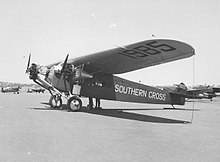
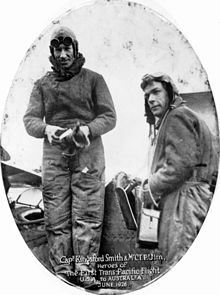
In 1928, Kingsford Smith and Charles Ulm arrived in the United States and began to search for an aircraft. Famed Australian polar explorer Sir Hubert Wilkins sold them a Fokker F.VII/3m monoplane, which they named the Southern Cross.
At 8:54 a.m. on 31 May 1928, Kingsford Smith and his 4-man crew left Oakland, California, to attempt the first trans-Pacific flight to Australia. The flight was in three stages. The first, from Oakland to Wheeler Army Airfield, Hawaii, was 3,870 kilometres (2,400 mi), taking an uneventful 27 hours 25 minutes (87.54 mph). They took off from Barking Sands on Mana, Kauai, since the runway at Wheeler was not long enough. They headed for Suva, Fiji, 5,077 kilometres (3,155 mi) away, taking 34 hours 30 minutes (91.45 mph). This was the most demanding portion of the journey, as they flew through a massive lightning storm near the equator. The third leg was the shortest, 2,709 kilometres (1,683 mi) in 20 hours (84.15 mph), and crossed the Australian coastline near Ballina before turning north to fly 170 kilometres (110 mi) to Brisbane, where they landed at 10.50 a.m. on 9 June. The total flight distance was approximately 11,566 kilometres (7,187 mi). Kingsford Smith was met by a huge crowd of 26,000 at Eagle Farm Airport, and was welcomed as a hero. Australian aviator Charles Ulm was the relief pilot. The other crewmen were Americans, they were James Warner, the radio operator, and Captain Harry Lyon, the navigator and engineer.
The National Film and Sound Archive of Australia has a film biography of Kingsford Smith, called An Airman Remembers, and recordings of Kingsford Smith and Charles Ulm talking about the journey.
A stamp sheet and stamps, featuring the Australian aviators Charles Kingsford Smith and Charles Ulm, were released by Australia Post in 1978, commemorating the 50th anniversary of the flight.
A young New Zealander named Jean Batten attended a dinner in Australia featuring Kingsford Smith after the trans-Pacific flight and told him "I'm going to learn to fly." She later convinced him to take her for a flight in the Southern Cross and went on to become a record-setting aviator, following his example instead of his advice ("Don't attempt to break men's records – and don't fly at night", he told her in 1928 and remembered wryly later).
1928 Trans-Tasman flight
After making the first non-stop flight across Australia from Point Cook near Melbourne to Perth, in Western Australia in August 1928, Kingsford Smith and Charles Ulm registered themselves as Australian National Airways (see below). They then decided to attempt the Tasman crossing to New Zealand not only because it had never yet been done, but also in the hope the Australian Government would grant Australian National Airways a subsidised contract to carry scheduled mail regularly. The Tasman had remained unflown after the failure of the first attempt in January 1928, when New Zealanders John Moncrieff and George Hood had vanished without trace.
Kingsford Smith's flight was planned for take off from Richmond, near Sydney, on Sunday 2 September 1928, with a scheduled landing around 9:00 a.m. on 3 September at Wigram Aerodrome, near Christchurch, the principal city in the South Island of New Zealand. This plan drew a storm of protest from New Zealand churchmen about ‘setting the sanctity of the sabbath at nought’.

The mayor of Christchurch supported the churchmen and cabled a protest to Kingsford Smith. As it happened, unfavourable weather developed over the Tasman and the flight was deferred, so it is not known whether or how Kingsford Smith would have heeded the cable.
Accompanied by Charles Ulm, navigator Harold Arthur Litchfield, and radio operator Thomas H. McWilliams, a New Zealander made available by the New Zealand Government, Kingsford Smith left Richmond in the evening of 10 September, planning to fly overnight to a daylight landing after a flight of about 14 hours. The 2,600 kilometres (1,600 mi) planned route was only just over half the distance between Hawaii and Fiji. After a stormy flight, at times through icing conditions, the Southern Cross made landfall in much improved weather near Cook Strait, the passage between New Zealand's two main islands. At an estimated 241 kilometres (150 mi) out from New Zealand, the crew had dropped a wreath in memory of the two New Zealanders who had disappeared during their attempt to cross the Tasman earlier that year.
There was a tremendous welcome in Christchurch, where the Southern Cross landed at 0922 after a flight of 14 hours and 25 minutes. About 30,000 people made their way to Wigram, including many students from state schools, who were given the day off, and public servants, who were granted leave until 11 a.m. The event was also broadcast live on radio.
While the New Zealand Air Force overhauled the Southern Cross free of charge Kingsford Smith and Charles Ulm were taken on a triumphant tour of New Zealand, flying in Bristol Fighters.
The return to Sydney was made from Blenheim, a small city at the north of the South Island. Hampered by fog, severe weather and a minor navigational error, the flight to Richmond took over 23 hours; on touchdown the aircraft had enough fuel for only another 10 minutes flying.
Australian National Airways
"Coffee Royal" incident
On 31 March 1929, en route from Sydney to England, the Southern Cross with Kingsford Smith at the helm made an emergency landing on a mudflat near the mouth of the Glenelg River, in the Kimberley region of northern Western Australia. The Southern Cross was found and rescued after a fortnight's searching, with George Innes Beard, Albert Barunga and Wally from the Kunmunya Mission the first overland party to reach the downed aircraft.
While on their way to help with the search two friends of Kingsford Smith crash landed in the Tanami Desert in Central Australia and died of thirst and exposure on 12 April 1929. The pair, Keith Vincent Anderson and Henry Smith "Bobby" Hitchcock, had been flying a Westland Widgeon plane named Kookaburra. Many sections of the media and public felt that the forced landing of the Southern Cross, which was dubbed the "Coffee Royal" incident after the brew of coffee and brandy which the crew had drunk while awaiting rescue, had been a publicity stunt and that Kingsford Smith was responsible for the two deaths. Despite him being exonerated by an official enquiry Kingsford Smith's reputation within Australia never fully recovered during his lifetime.
The bodies of Anderson and Hitchcock were later recovered from the Tanami Desert. Hitchcock's body was returned to Perth for burial at Karrakatta Cemetery, while Anderson's body was returned to Sydney. Over 6000 mourners attended Keith Anderson's funeral. It was an elaborate affair befitting a national hero. Anderson was buried at Rawson Park, Mosman, on 6 July 1929. A grand memorial was later erected at the gravesite in his honour.
Later flights

Collecting his 'old bus', Southern Cross, from the Fokker Aircraft Company in the Netherlands where it had been overhauled, in June 1930 he achieved an east-west crossing of the Atlantic from Ireland to Newfoundland in 31½ hours, having taken off from Portmarnock Beach (The Velvet Strand), just north of Dublin. New York gave him a tumultuous welcome. The Southern Cross continued on to Oakland, California, completing a circumnavigation of the world, begun in 1928. In 1930, he competed in an England to Australia air race, and, flying solo, won the event taking 13 days. He arrived in Sydney on 22 October 1930.
In 1931, he purchased an Avro Avian he named the Southern Cross Minor, to attempt an Australia-to-England flight. He later sold the aircraft to Captain W.N. "Bill" Lancaster who vanished on 11 April 1933 over the Sahara Desert; Lancaster's remains were not found until 1962. The wreck of the Southern Cross Minor is now in the Queensland Museum. Also in 1931, Smith began developing the Southern Cross automobile as a side project.
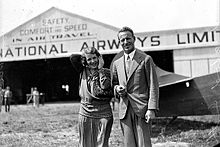
In 1933, Seven Mile Beach, New South Wales, was used by Sir Charles Kingsford Smith as the runway for the first commercial flight between Australia and New Zealand.
In 1934, he purchased a Lockheed Altair, the Lady Southern Cross, with the intention of competing in the MacRobertson Air Race. He was unable to make it to England in time for the start of the race, and so flew the Lady Southern Cross from Australia to the United States instead; the first eastward crossing of the Pacific Ocean by aircraft.
Disappearance and death
Sir Charles Kingsford Smith and co-pilot John Thompson "Tommy" Pethybridge were flying the Lady Southern Cross overnight from Allahabad, India, to Singapore, as part of their attempt to break the England-Australia speed record held by C. W. A. Scott and Tom Campbell Black, when they disappeared over the Andaman Sea in the early hours of 8 November 1935. Despite a brave search for 74 hours over Bay of Bengal by test pilot Eric Stanley Greenwood OBE their bodies were never recovered.
Eighteen months later, Burmese fishermen found an undercarriage leg and wheel (with its tyre still inflated) which had been washed ashore at Aye Island in the Gulf of Martaban, 3 km (2 mi) off the southeast coastline of Burma, some 137 km (85 mi) south of Mottama (formerly known as Martaban). Lockheed confirmed the undercarriage leg to be from the Lady Southern Cross. Botanists who examined the weeds clinging to the undercarriage leg estimated that the aircraft itself lies not far from the island at a depth of approximately 15 fathoms (90 ft; 27 m). The undercarriage leg is now on public display at the Powerhouse Museum in Sydney, Australia.
In 2009, filmmaker and explorer Damien Lay stated he was certain he had found the Lady Southern Cross. The location of the claimed find was widely misreported as "in the Bay of Bengal". However, the 2009 search was in fact at the same location where the landing gear had been found in 1937, at Aye Island in the Andaman Sea.
Kingsford Smith was survived by his wife, Mary Kingsford Smith, and their three-year-old son Charles Jnr. Kingsford Smith's autobiography, My Flying Life, was published posthumously in 1937 and became a best seller.
Following The Joint Australian Myanmar Lady Southern Cross Search Expedition II (LSCSEII) in 2009, Lay conducted a total of ten further expeditions to Myanmar to recover wreckage from the site. In 2011, Lay claimed to have found the wreckage, but that claim has been widely disputed, and no evidence confirming the claim has been forthcoming. The location of the site, approximately 1.8 miles off the coast of Myanmar has never been publicly released.
Lay has worked closely with both the Kingsford Smith and Pethybridge families since 2005. The privately funded project now running in its 8th year has been supported by the government and people of Myanmar.
Honours and legacy
Kingsford Smith was knighted in the 1932 King's Birthday Honours List as a Knight Bachelor. He received the accolade on 3 June 1932 from the Australian Governor-General Sir Isaac Isaacs for services to aviation and later was appointed honorary Air Commodore of the Royal Australian Air Force.
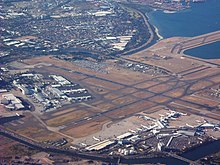
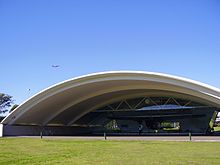
The major airport of Sydney, located in the suburb of Mascot, was named Kingsford Smith International Airport in his honour. The federal electorate surrounding the airport is named the Division of Kingsford Smith, and includes the suburb of Kingsford.
His most famous aircraft, the Southern Cross, is now preserved and displayed in a purpose-built memorial to Sir Charles Kingsford Smith near the International Terminal at Brisbane Airport. Kingsford Smith sold the plane to the Australian Government in 1935 for £3000 so it could be put on permanent display for the public. The plane was carefully stored for many years before the current memorial was built.
Kingsford Smith Drive in Brisbane passes through the suburb of his birth, Hamilton. Another Kingsford Smith Drive, which is located in the Canberra district of Belconnen, intersects with Southern Cross Drive.
Opened in 2009, Kingsford Smith School in the Canberra suburb of Holt was named after the famous aviator, as was Sir Charles Kingsford-Smith Elementary School in Vancouver, British Columbia, Canada.
He was pictured on the Australian $20 paper note (in circulation from 1966 until 1994, when the $20 polymer note was introduced to replace it), to honour his contribution to aviation and his accomplishments during his life. He was also depicted on the Australian one-dollar coin of 1997, the centenary of his birth.
Albert Park in Suva, where he landed on the trans-Pacific flight, now contains the Kingsford Smith Pavilion.
A memorial stands at Seven Mile Beach (New South Wales) commemorating the first commercial flight to New Zealand.
Qantas named its sixth Airbus A380 (VH-OQF) after Kingsford Smith.
KLM named one of its Boeing 747s (PH-BUM) after Kingsford Smith.
A satellite of Saturn, Kingsford Smith is named after him.
A personal memorial
Australian aviation enthusiast Austin Byrne was part of the large crowd at Sydney's Mascot Aerodrome in June 1928 to welcome the Southern Cross and its crew following their successful trans-Pacific flight. Witnessing this event inspired Byrne to make a scale model of the Southern Cross to give to Kingsford Smith. After the aviator's disappearance, Bryne continued to expand and enhance his tribute with paintings, photographs, documents, and art works he created, designed or commissioned. Between 1930 and his death in 1993, Byrne devoted his life to creating and touring his Southern Cross Memorial.
Popular culture
- Kingsford Smith made a cameo as himself in the feature film Splendid Fellows (1934).
- A popular documentary was made about his life: The Old Bus (1934).
- The 1946 Australian film Smithy was based on his life, with Ron Randell as Charles Kingsford Smith and John Tate as Charles Ulm.
- The 1985 Australian television mini-series A Thousand Skies, has John Walton as Kingsford Smith and Andrew Clarke as Ulm.
- Bill Bryson details Kingsford Smith's life in his book "Down Under"
- Australian author Peter FitzSimons's book, CHARLES KINGSFORD SMITH and Those Magnificent Men, details an extensive exploration of Smithy's life and of aviation history – Published by Harper Collins, Australia. 2009. (ISBN 978 0 7322 8819 8).
Also commemorating him are:
- The songs "Kingsford Smith, Aussie is Proud of You" and "Smithy" by Len Maurice (1928);
- The songs "Smithy" and "Heroes of the Air" by Fred Moore (1928);
- The songs "Smithy The King of the Air" and "The Southern Cross Monologue" by Clement Williams.
